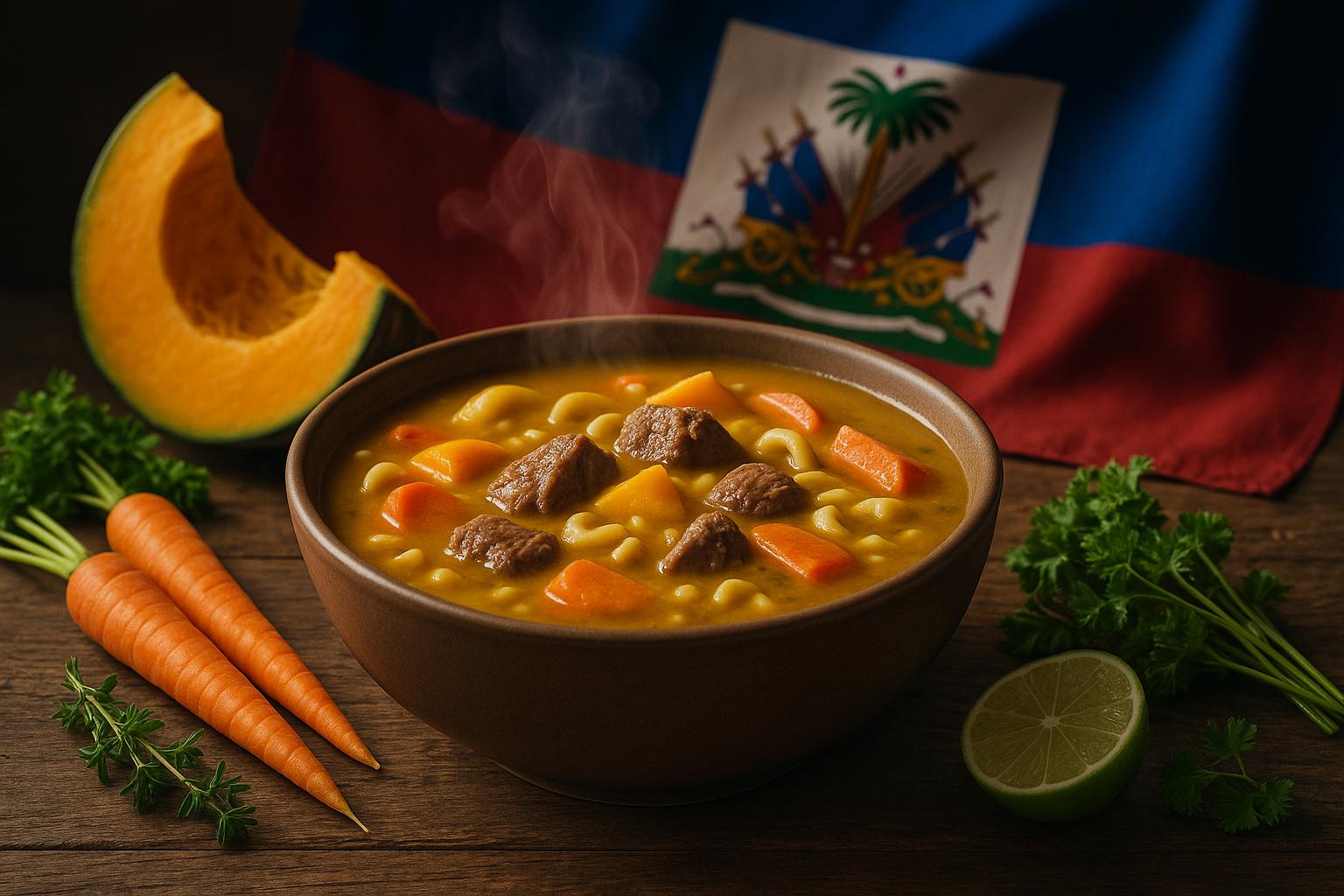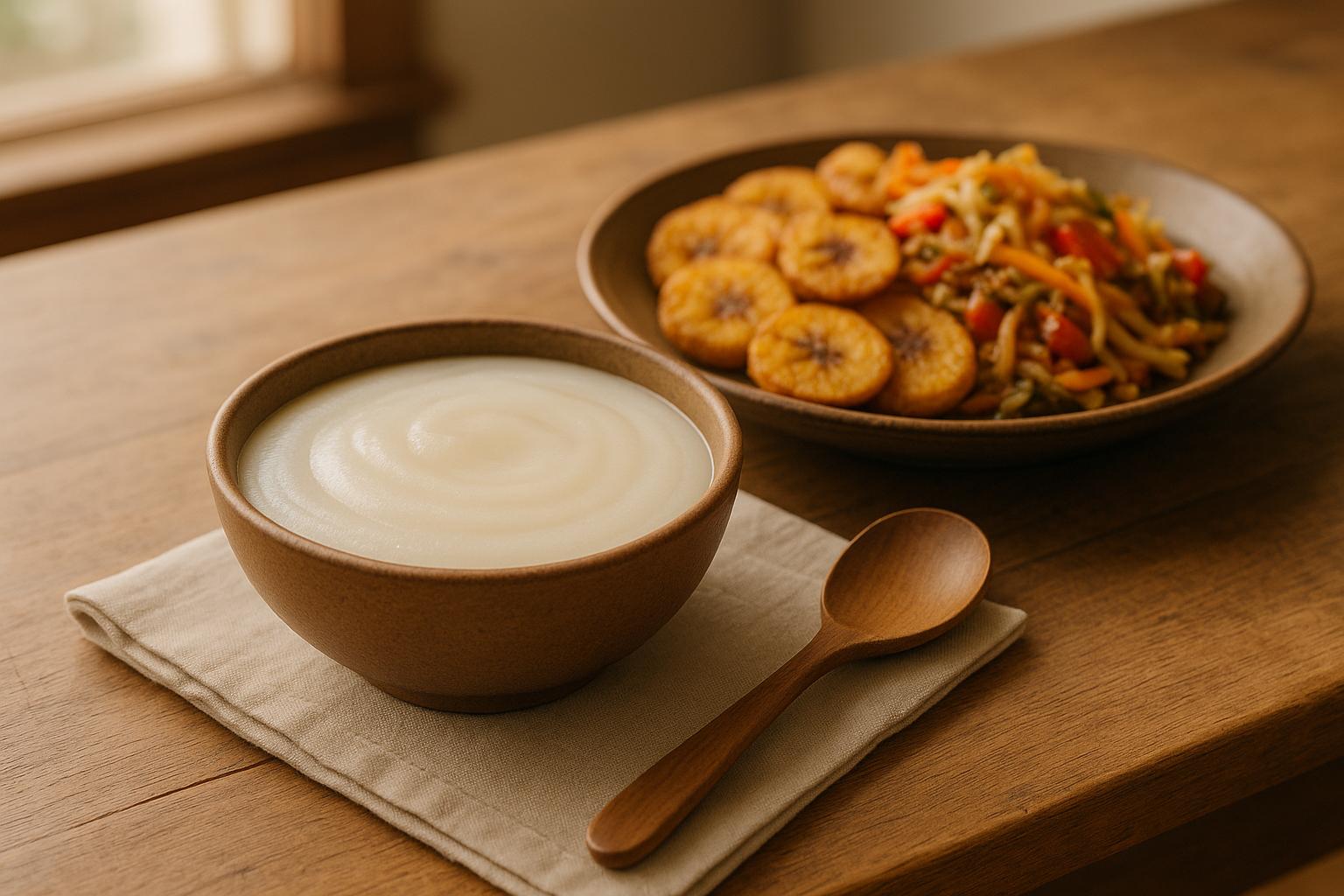Haitian food takes time because it focuses on deep flavors, traditional methods, and careful preparation. Here's why:
- Marination: Meat is marinated for hours, sometimes overnight, using epis (a spice blend) to infuse flavor.
- Slow Cooking: Techniques like simmering (2+ hours) ensure tender meat and rich, layered tastes.
- Meticulous Preparation: Cleaning meat with lime, vinegar, and hot water is a key step, followed by making spice bases like epis.
Haitian cooking reflects history and culture, blending African, Indigenous, French, and Caribbean influences. Dishes like Griot, Tassot, and Soup Joumou require patience but deliver bold, unforgettable flavors.
Key takeaway: Haitian cuisine is a labor of love, where time and effort create dishes that honor heritage and tradition.
How To Make Haitian Griot (Fried Pork)
History Behind Haitian Cooking Methods
Haitian cooking methods are deeply rooted in traditions that have been passed down through generations. These practices were not just about creating meals but also preserving culture and adapting to the challenges of survival.
Mixed Heritage of Haitian Food
Haitian cuisine is a beautiful blend of culinary traditions from various cultures, each leaving its mark on the methods and flavors. Here's a quick look at how these influences shaped Haitian cooking:
| Cultural Origin | Key Contributions |
|---|---|
| Taíno | Techniques for cassava and maize preparation |
| African | Mastery of spice blending and communal cooking rituals |
| French | Sauce-making and refined culinary methods |
At the heart of Haitian cooking is épice, a rich and flavorful base made from peppers, garlic, and herbs. This essential sauce showcases the ingenuity of Haitian cooks, who transform simple, everyday ingredients into dishes bursting with flavor.
"Haitian cuisine is a vibrant and flavorful reflection of the country's rich cultural heritage, blending influences from African, French, Spanish, and indigenous Taíno traditions."
– Emmanuela Douyon, POLICITÉ Founder
These diverse culinary influences not only shape daily meals but also play a central role in the communal and celebratory aspects of Haitian life.
Food in Celebrations
One of the most iconic celebratory dishes in Haiti is Soup Joumou, which earned a spot on UNESCO's Intangible Cultural Heritage List in 2021. This dish is more than just a meal - it’s a symbol of family, tradition, and resilience. Faced with limited resources, Haitian cooks developed preservation techniques like washing with salt, treating with citrus, scalding in hot water, and seasoning with epis.
"Understanding the landscape of Haitian culture is very important in understanding Haitian cuisine. As mentioned before, each dish has a story. Some Haitian dishes stem from rituals, spirituality, and connecting with nature."
– Alain Lemaire
The time and effort invested in preparing Haitian dishes ensure that every bite carries the spirit of the past while honoring the rich cultural heritage of the present.
Time-Intensive Cooking Methods
Haitian cuisine is all about building layers of flavor through deliberate and intricate cooking techniques. Each step is designed to create the rich and distinctive taste that defines this culinary tradition.
Marination Steps
Marination is a cornerstone of Haitian cooking. It begins with a blend of salt and acidic ingredients like sour orange or lime juice, which not only enhance flavor but also help preserve the meat. The star of this process is epis - a vibrant paste made from scallions, garlic, scotch bonnet peppers, cloves, fresh thyme, and parsley. This paste is worked into the meat thoroughly, ensuring the flavors penetrate deep into both the surface and interior. After marinating, the ingredients are slowly simmered to bring out their full potential.
Simmering Process
Slow simmering is another essential technique in Haitian cooking, particularly for stews and sauces. This method allows flavors to deepen and meld together while tenderizing meats and vegetables. It’s a patient process, but the result is a rich, hearty dish packed with complex flavors. To complement this, the preparation of epis - a signature spice base - plays a crucial role in defining Haitian cuisine.
Making Spice Bases
Epis is the backbone of Haitian cooking, and preparing it is an art in itself. There are two main ways to make this flavorful paste:
- Traditional Method: Using a wooden mortar and pestle (munsh pilon), the ingredients are carefully mashed into a paste, a process that requires time and effort.
- Modern Approach: For a quicker option, a food processor can be used to achieve similar results.
"If you have ever wondered what gives Haitian food that unique depth of flavour and flair, then the answer lies in the Haitian epis."
Once prepared, epis can be stored in the refrigerator for up to three months. This not only preserves its bold flavors but also saves time during future cooking, shaving at least 15 minutes off the preparation of each dish. Its natural acidity ensures the flavors remain vibrant and ready to enhance any meal.
Long-Prep Haitian Dishes
Haitian cuisine is known for its vibrant flavors and intricate cooking techniques, and dishes like Griot, Tassot, and Soup Joumou are prime examples. These recipes require patience and dedication, reflecting the rich culinary traditions and stories of Haiti.
Making Griot
Griot, a beloved Haitian dish, is all about layering flavors through careful preparation. The process begins with cleansing pork using citrus, followed by marination in epis (a Haitian seasoning blend), garlic, and more citrus. While the minimum marination time is 3 hours, many cooks extend it overnight to let the flavors fully develop. The cooking itself is a two-step process: first, the pork is simmered slowly for about two hours to achieve tenderness. Then, it’s fried to create a crispy outer layer while keeping the meat juicy on the inside.
"In this hallmark dish of Haiti, the marinade does all the heavy lifting. You marinate the pork overnight, put everything into a pot, and simmer it until it's super tender - easy peasy."
Preparing Tassot
Tassot, another Haitian favorite, follows a similar time-intensive approach. The meat is marinated in citrus juices, garlic, and a mix of Haitian spices, which not only infuses flavor but also tenderizes the meat. After marination, the meat is cooked to remove moisture and then fried, giving it a crispy texture. The result is a dish that's tangy, spicy, and slightly chewy - a true staple in Haitian kitchens.
Cooking Soup Joumou
Soup Joumou holds a special place in Haitian culture, particularly as a symbol of independence. Preparing this iconic soup is a labor of love, taking about 3 hours and 45 minutes, with over 2 hours of active cooking time. The process starts by pureeing pumpkin or squash to create the base. Vegetables and meats are added in stages, ensuring each ingredient is cooked perfectly and contributes to the soup’s depth of flavor. The result is a hearty, flavorful dish that stands as a testament to Haiti’s culinary heritage.
sbb-itb-80c33ff
Benefits of Long Cooking Times
Flavor Development
In Haitian cuisine, long cooking times are key to unlocking deep, layered flavors. Slow simmering transforms ingredients, allowing spices to blend harmoniously and enhancing both taste and texture. This process gives epis - a signature seasoning mix of garlic, parsley, chili pepper, cloves, onion, and lime - a chance to fully permeate the dish, creating a flavor profile that's both bold and balanced.
When used as a marinade, epis doesn't just flavor the surface; it seeps into the meat, tenderizing it while building complexity in every bite. Slow cooking also works its magic by breaking down tough connective tissues, yielding tender, melt-in-your-mouth results. Beyond just taste, this method preserves the nutrients and beneficial properties of spices, many of which are known for their antioxidant and anti-inflammatory qualities.
But the importance of slow cooking in Haitian cuisine goes beyond what’s on the plate - it’s a connection to heritage.
Preserving Food Traditions
Slow cooking isn’t just about flavor; it’s about keeping traditions alive. These time-honored cooking techniques serve as a bridge to Haiti's rich culinary history, shaped by African, Indigenous, French, and Caribbean influences.
Take Soup Joumou, for example - a dish steeped in symbolism. Its preparation honors Haiti's independence and freedom, showcasing traditional methods that have been lovingly passed down through generations.
"Haitian food is a labor of love." - Chef Alain Lemaire
Whether it’s the slow simmering of spices or the careful preparation of iconic dishes, these practices are a testament to Haiti’s enduring culinary legacy.
Conclusion
Haitian cuisine's slow cooking process is more than just a tradition - it's the heart and soul of its bold, layered flavors. As cookbook author Nadege Fleurimond puts it:
"Haitian food culture is defined by its bold flavors, resourcefulness, and the intentional use of fresh ingredients... It's a cuisine that thrives on slow cooking and layering flavors to create depth and balance".
Preparing an authentic Haitian meal often takes a minimum of four hours, showcasing the dedication and care invested in every dish. These time-honored techniques are a testament to the enduring legacy of Haitian cooking, preserving its authenticity across generations.
From the slow simmering of staples like rice and beans to the meticulous crafting of signature seasonings, every step contributes to the dish's depth and richness. This deliberate approach not only enhances the flavors but also weaves together the cultural heritage explored throughout this article.
FAQs
What ingredients are typically used in Haitian epis, and how do they enhance the flavor of dishes?
Haitian Epis: A Flavorful Seasoning Blend
Haitian epis is a vibrant seasoning mix made from fresh, aromatic ingredients like garlic, onions, bell peppers, scallions, parsley, thyme, and sometimes cilantro. These components are blended into a fragrant paste that serves as the backbone of countless Haitian recipes.
This herb-and-spice blend infuses dishes with layers of flavor, giving them a rich, unmistakably Caribbean character. Whether used to marinate meats or as the foundation for hearty stews, epis ensures that every bite bursts with well-developed, bold tastes. It's a staple in Haitian kitchens, celebrated for its ability to elevate everyday meals into something extraordinary.
Why does Haitian cuisine take time to cook, and how does it impact the nutritional value of the food?
Haitian cuisine's tradition of slow cooking does more than just enhance flavor - it helps preserve nutrients that might otherwise be lost with high-heat methods. By cooking at lower temperatures, vitamins and minerals stay intact, keeping dishes wholesome and nutrient-packed.
This approach also works wonders for tougher cuts of meat, breaking them down into tender, flavorful bites. Plus, it gives spices and other ingredients time to meld, resulting in rich, layered flavors. The emphasis on fresh, whole ingredients - like legumes, vegetables, and grains - further boosts the nutritional value, adding fiber, protein, and other essentials for a well-rounded, satisfying meal.
Why is Soup Joumou a powerful symbol of Haitian independence and culture?
Soup Joumou: A Symbol of Freedom and Pride
Soup Joumou carries profound historical and emotional weight in Haiti. Under French colonial rule, this rich, pumpkin-based soup was a delicacy reserved for the enslavers, while enslaved Haitians were forbidden from partaking in it. But everything changed on January 1, 1804, when Haiti declared its independence. The Haitian people reclaimed the soup, turning it into a powerful emblem of their freedom and resilience.
Now, every year on Independence Day, Haitians come together to share Soup Joumou. It’s more than just a meal - it’s a celebration of liberation and a tribute to Haiti’s status as the first independent Black republic. The journey of this dish, from a symbol of oppression to one of unity and pride, speaks volumes about the enduring strength and spirit of the Haitian people.


